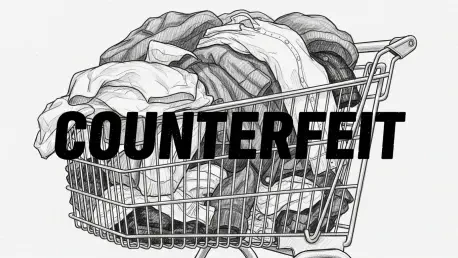Understanding the Counterfeit E-Commerce Landscape
Imagine a digital marketplace where a pair of sneakers, seemingly identical to a high-end brand, is available at a fraction of the cost, delivered in days rather than months, reshaping the very foundation of consumer trust and global trade. This scenario is not a futuristic fantasy but a daily reality in the realm of counterfeit e-commerce, a phenomenon that has surged to prominence, significantly altering the fabric of global trade. This shadow industry, often operating under the guise of legitimate platforms, has grown at an alarming rate, challenging the very notions of authenticity and trust in online shopping. The scale of this issue is staggering, with fake goods estimated to account for 2.5% of global trade, forming a $500 billion underground economy that thrives on imitation and deception.
A significant portion of this illicit market is driven by tech-savvy operations, predominantly based in China, where platforms like Temu and Shein have carved out substantial influence. Temu, for instance, commands 25% of Google shopping ads, positioning itself as a formidable competitor to established giants like Amazon by mimicking their interfaces and user experiences. These platforms capitalize on the inability of many consumers to distinguish between genuine and counterfeit products, flooding digital marketplaces with replicas across various segments such as fashion, technology, and sports goods. The sophistication of these operations often blurs the line between real and fake, creating a pervasive challenge for both buyers and legitimate businesses.
The technological advancements fueling this trend are equally concerning, with counterfeiters employing AI-generated listings to optimize search visibility and blockchain-based tactics to evade detection by authorities. Such innovations enable rapid scaling of operations, allowing counterfeit goods to infiltrate markets with unprecedented efficiency. As a result, distinguishing authentic products from fakes in online environments has become a daunting task, eroding consumer confidence and posing systemic risks to the integrity of global commerce.
Market Dynamics and Consumer Behavior
Key Trends Driving Counterfeit E-Commerce
The speed and affordability of counterfeit production stand out as primary drivers of this underground economy. For example, factories in regions like Guangzhou can churn out replicas of popular items, such as fake Nike Air Jordans, in just 11 days at a cost of $29, compared to the 18 months and $220 price tag for originals. This rapid turnaround and low pricing make counterfeit goods an attractive option for budget-conscious consumers, often overshadowing concerns about quality or legality. The accessibility of these products through digital channels further amplifies their reach, reshaping purchasing patterns worldwide.
Social media platforms play a pivotal role in this dynamic, acting as powerful amplifiers for counterfeit sales. Channels like Instagram and TikTok, through hashtags and influencer-driven content, often promote fake goods either inadvertently or deliberately, normalizing their presence in mainstream culture. Unboxing videos and trendy hashtags create a veneer of legitimacy, drawing in younger demographics who prioritize affordability and immediacy. This trend underscores a cultural shift where the allure of a bargain frequently trumps ethical considerations or brand allegiance.
Consumer behavior has also evolved significantly, with data indicating that 34% of online shoppers knowingly purchase knockoffs, driven by price sensitivity over authenticity. This shift is compounded by emerging opportunities for counterfeiters, such as social commerce platforms and algorithmic biases that favor cheaper, fake listings over legitimate ones in search results. These factors collectively create a fertile ground for counterfeit e-commerce to flourish, challenging traditional market structures and consumer trust at every turn.
Market Scale and Growth Projections
Current estimates peg the counterfeit market at a staggering $500 billion, with projections suggesting it could balloon to $1.89 trillion by 2030 if unchecked. This growth trajectory points to the emergence of a parallel economy that rivals conventional trade systems in both scale and complexity. In key regions like China, where 43% of online products are reportedly counterfeit, the sheer volume of fake goods undermines confidence in digital transactions, casting a shadow over the reliability of e-commerce as a whole.
Performance indicators reveal the depth of this issue, with high counterfeit rates directly impacting consumer perceptions and purchasing decisions. The consistent influx of fake products into mainstream platforms not only distorts market competition but also erodes the value of intellectual property for authentic brands. As these numbers grow, the economic ramifications become more pronounced, affecting everything from small businesses to multinational corporations.
Looking ahead, the potential for counterfeit e-commerce to redefine global trade structures is undeniable. If current trends persist, this shadow market could solidify its position as a formidable counterpart to legitimate commerce, challenging regulators and businesses to rethink strategies for maintaining market integrity. The implications of such a shift extend beyond economics, influencing societal norms around consumption and value in an increasingly digital world.
Challenges Posed by Counterfeit E-Commerce
The rise of counterfeit e-commerce presents multifaceted challenges for legitimate brands, regulators, and consumers alike. One of the most pressing issues is the erosion of trust in online marketplaces, exemplified by platforms like Amazon, where over half of the sellers hail from China, often peddling questionable goods. This pervasive uncertainty damages brand reputation and consumer confidence, as buyers struggle to verify the authenticity of their purchases amidst a flood of fakes.
Technological hurdles further complicate the battle against counterfeits, with illicit operations leveraging tactics such as ghost warehouses and blockchain stores to remain elusive. These methods allow counterfeiters to bypass traditional detection mechanisms, rendering many enforcement efforts futile. The agility of these operations contrasts sharply with the slower, often reactive responses from legitimate entities, creating an uneven playing field that favors deception over transparency.
Market-driven challenges also play a significant role, as economic incentives push consumers toward cheaper alternatives, undermining loyalty to authentic brands. While solutions like anti-cloning algorithms and initiatives such as Amazon’s Project Zero aim to combat this trend, their effectiveness remains limited against the adaptability of counterfeit networks. Addressing these issues requires a concerted effort to innovate beyond current capabilities, balancing consumer education with robust technological interventions to restore faith in digital commerce.
Regulatory Frameworks and Enforcement Struggles
Navigating the regulatory landscape of counterfeit e-commerce reveals a stark mismatch between existing laws and the rapid pace of technological advancements exploited by illicit operators. Current legal frameworks often lag behind, unable to address the sophisticated methods used to distribute fake goods across borders. This gap leaves authorities grappling with an uphill battle to curb a problem that evolves faster than policy can adapt.
Significant enforcement efforts, such as the 38% increase in U.S. Customs seizures over a recent five-year period, highlight the scale of the issue but also their limited impact. Tactics like ghost warehouses allow counterfeiters to evade capture, while platforms like TikTok and Shein exploit legal loopholes through strategic buyouts and deals, complicating crackdowns on intellectual property violations. This environment, often described as a “whack-a-mole” game, underscores the frustration of regulators attempting to maintain order in a chaotic digital marketplace.
The pressing need for enhanced compliance and security measures is evident, as these elements are critical to shaping industry practices. Without a unified, forward-thinking approach to regulation, the counterfeit sector will continue to exploit systemic weaknesses, perpetuating economic and ethical challenges. Strengthening international cooperation and updating legal standards to match technological realities remain essential steps toward mitigating this pervasive threat.
The Future of Global Trade in the Shadow of Counterfeits
Envisioning the trajectory of global trade amidst the counterfeit surge reveals contrasting potential outcomes. One scenario, dubbed a “TikTok Shoppocalypse,” foresees social commerce platforms driving an unprecedented wave of counterfeit sales, capitalizing on viral trends and impulse buying, which has already risen by 37%. Alternatively, an “Authenticity Renaissance” could emerge, powered by blockchain and Web3 verification technologies, offering hope for restoring trust through verifiable digital identities for products.
Emerging innovations, such as virtual reality dressing rooms that reduce return rates and Nike’s .Swoosh patents for digital authenticity, signal potential disruptions that could tilt the balance toward legitimacy. However, economic risks loom large, with market losses estimated at $200 billion due to counterfeit proliferation. These developments, coupled with shifting consumer preferences, suggest a volatile landscape where adaptability will determine survival for both brands and regulators.
Global economic conditions and the specter of regulatory “Armageddon” through digital trade wars add further complexity to this future. The role of innovation remains a double-edged sword, capable of either entrenching counterfeit dominance or paving the way for trust restoration through cutting-edge solutions. As these forces converge, the decisions made by stakeholders today will shape whether global trade succumbs to deception or reclaims integrity as a cornerstone of commerce.
Conclusion and Strategic Outlook
Reflecting on the extensive analysis conducted, it becomes clear that counterfeit e-commerce has established itself as a systemic challenge to global trade, consumer trust, and regulatory frameworks. The dual nature of counterfeiters as both threats and unintended innovators has forced legitimate brands into a reactive posture, compelling adaptation to avoid obsolescence. The scale of this shadow economy, coupled with its technological sophistication, underscores a critical juncture for the industry.
Moving forward, stakeholders are urged to invest in authenticity-driven technologies like blockchain to create verifiable product trails, ensuring transparency in digital transactions. Fostering consumer education on the risks associated with counterfeit goods emerges as another vital strategy, empowering buyers to make informed choices. Additionally, collaborative efforts between brands, policymakers, and tech innovators are deemed essential to develop adaptive regulations that can keep pace with evolving tactics.
Ultimately, the path ahead hinges on a collective commitment to prioritize integrity over short-term gains, recognizing that every online purchase shapes the future of digital commerce. By embracing proactive measures and leveraging technological advancements, there is potential to transform this challenge into an opportunity for rebuilding trust and redefining value in a rapidly changing global marketplace.









